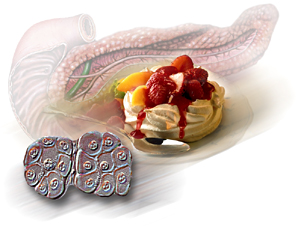|
|||||||||
|
Al-Enaya |
||||||||
|
Diabetes |
|||||||||
|
The Beginning of Diabetes treatment:
Diabetes has been recognized as a medical condition for at least 3,500 years, but what caused the disease was a mystery until the early 1900s. Ancient physicians diagnosed diabetes by the sweet taste in the urine that was due to the presence of large amounts of sugar.
The best way to stay in control your diabetes is to proactively manage it. Keep a complete list of the medications you are taking, this includes over-the-counter, prescription and alternative treatments. Share this list with your healthcare providers and pharmacist. Seek their advice on the possible side effects of your medications.
Insulin There are more than 20 types of insulin sold in the United States that differ in how they are made, how they work in the body, and price. Insulin can be modeled precisely after human insulin (known as "human recombinant insulin") or may come from animal sources (pigs or cows). There are different types of insulin based on how soon the insulin starts working (onset), when it works the hardest (peak time) and how long it lasts in your body (duration). Some insulins also come mixed together, making it easier to inject two kinds of insulin at the same time. Many people who take insulin use a syringe, but other methods of delivery include a pen and an insulin pump.
A common side effect from insulin is a hypoglycemic attack resulting from low blood glucose levels. It is important to know the warning signs for hypoglycemia and always be prepared to treat hypoglycemia immediately. The most accurate way to determine if you are experiencing hypoglycemia is to test your blood sugar.
Oral Medication Today there are five different classes of diabetes medications that work in the body to improve blood glucose levels for people with type 2 diabetes. Here is a look at where we are today with the wide range of oral medications available and the common side effects for each.
Sulfonylureas This class of drugs works by stimulating the pancreas to release more insulin and is often one of the first oral therapies given to people with type 2 diabetes. Common side effects include weight gain, mild gastrointestinal disturbances, alcohol intolerance, mild skin irritations and hypoglycemia or low blood glucose levels.
Biguanides (Metformin) This drug is often prescribed in combination therapy with other diabetes medications or insulin, and can be used as a first line of treatment. This class works by keeping the liver from releasing too much glucose and helping the body better respond to its own insulin. Metformin, on its own, can minimize the risk of hypoglycemic attacks. Common side effects may include nausea, diarrhea or mild gastrointestinal disturbances and loss of appetite.
Alpha-Glucosidase Inhibitors This class of drugs helps delay the digestion of sugars and carbohydrates by releasing them slowly into the system, avoiding high blood glucose levels after meals. Common side effects include nausea, diarrhea, mild gastrointestinal disturbances, bloating and gas. It is important to know that over-the-counter enzymes, to treat the gas caused by this drug may weaken the effects of acarbose. Talk to your doctor about possible
Thiazolidinediones (TZD) This class helps sensitize the muscle cells to insulin and reduce the amount of glucose released by the liver, resulting in increased glucose uptake. Side effects vary among the brands available, and can include adverse affects to the liver. Symptoms of liver damage include nausea, vomiting, abdominal pain, fatigue, loss of appetite and dark urine. Before using this class of drugs you should have a blood test for liver function and once prescribed, additional tests every month for the first eight months of therapy. If you experience any of these symptoms talk to your doctor immediately.
|
Information Flyers
(all documents in pdf-format)
Leaflet 592 KB



